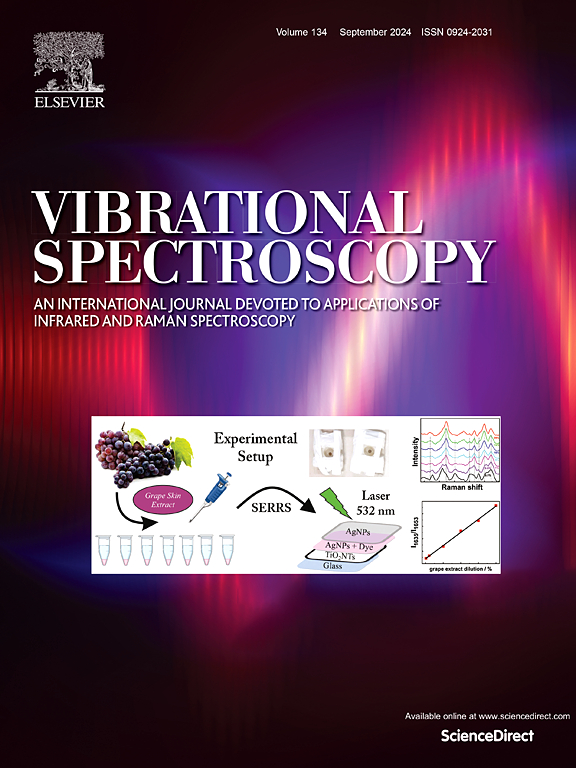Surface-enhanced Raman spectroscopy coupled with DFT for sensitive detection of tadalafil in complex matrices
IF 3.1
3区 化学
Q2 CHEMISTRY, ANALYTICAL
引用次数: 0
Abstract
Tadalafil (TDF), a widely prescribed phosphodiesterase-5 inhibitor, is not only a clinically important pharmaceutical for erectile dysfunction but also a frequently encountered adulterant in counterfeit supplements, raising serious public health and regulatory concerns. This study presents a novel and integrated approach for the sensitive and selective detection of TDF in complex commercial matrices, combining experimental Surface-Enhanced Raman Scattering (SERS) spectroscopy with Density Functional Theory (DFT) simulations. The molecular geometry of TDF was optimized at the B3LYP/6–311 G(d) level, and theoretical Raman and SERS spectra were generated using a mixed basis set. A molecular electrostatic potential (MEP) map was constructed to identify key adsorption sites, offering mechanistic insights into SERS enhancement. Experimentally, gold-capped silicon nanopillar (AuNP) substrates enabled detection of TDF across a wide concentration range (0.75–100 µM). Through SERS mapping and calibration, we established a linear correlation between signal intensity and TDF concentration. Most importantly, the method demonstrated real-world applicability by successfully detecting TDF in spiked commercial multivitamin tablets. Finally, this work provides a robust sensing platform for detecting illicit pharmaceutical adulterants, bridging theoretical modeling with practical SERS analytics, and offering valuable tools for regulatory monitoring and consumer safety.
表面增强拉曼光谱耦合DFT用于复杂基质中他达拉非的灵敏检测
他达拉非(TDF)是一种广泛使用的磷酸二酯酶-5抑制剂,不仅是临床上治疗勃起功能障碍的重要药物,而且也是假冒补充剂中经常遇到的掺假成分,引起了严重的公共卫生和监管问题。本研究提出了一种新的综合方法,将实验表面增强拉曼散射(SERS)光谱与密度泛函理论(DFT)模拟相结合,用于复杂商业矩阵中TDF的敏感和选择性检测。在B3LYP/ 6-311 G(d)水平上对TDF的分子几何结构进行优化,并使用混合基集生成理论拉曼和SERS光谱。构建了分子静电势(MEP)图来确定关键的吸附位点,为SERS增强提供了机制见解。实验中,金顶硅纳米柱(AuNP)衬底可以在宽浓度范围(0.75-100 µM)内检测TDF。通过SERS制图和校准,我们建立了信号强度与TDF浓度之间的线性相关关系。最重要的是,该方法通过成功地检测加标商业复合维生素片中的TDF,证明了其在现实世界中的适用性。最后,这项工作为检测非法药物掺假提供了一个强大的传感平台,将理论建模与实际SERS分析联系起来,并为监管监测和消费者安全提供了有价值的工具。
本文章由计算机程序翻译,如有差异,请以英文原文为准。
求助全文
约1分钟内获得全文
求助全文
来源期刊

Vibrational Spectroscopy
化学-分析化学
CiteScore
4.70
自引率
4.00%
发文量
103
审稿时长
52 days
期刊介绍:
Vibrational Spectroscopy provides a vehicle for the publication of original research that focuses on vibrational spectroscopy. This covers infrared, near-infrared and Raman spectroscopies and publishes papers dealing with developments in applications, theory, techniques and instrumentation.
The topics covered by the journal include:
Sampling techniques,
Vibrational spectroscopy coupled with separation techniques,
Instrumentation (Fourier transform, conventional and laser based),
Data manipulation,
Spectra-structure correlation and group frequencies.
The application areas covered include:
Analytical chemistry,
Bio-organic and bio-inorganic chemistry,
Organic chemistry,
Inorganic chemistry,
Catalysis,
Environmental science,
Industrial chemistry,
Materials science,
Physical chemistry,
Polymer science,
Process control,
Specialized problem solving.
 求助内容:
求助内容: 应助结果提醒方式:
应助结果提醒方式:


